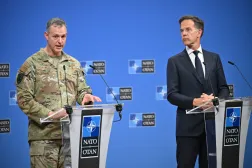NATO seeks to confront the growing ‘pressure of hybrid war’

NATO leaders sharply condemned hybrid warfare threats in a new communiqué, as reports of such adversarial sabotage, cyberattacks, electronic interference, and other malign activities to undermine the alliance’s members continue to intensify.
In on-stage briefings and sideline conversations with DefenseScoop at the NATO summit last week, senior officials from multiple nations in the alliance discussed recent moves — including a blatant call-out and new measures in the Washington Summit Declaration — to accelerate plans that will help them collectively prepare for and defend against hybrid warfare tactics from Russia, China and elsewhere.
“These threats are present, real and increasingly tangible,” a British government official told DefenseScoop.
Hybrid warfare involves a mix of conventional and unconventional methods that state and non-state actors use to destabilize and sow doubt in the minds of target populations.
The scale and intensity of these covert and overt activities — like spreading disinformation, sending groups of migrants to storm borders, jamming GPS signals, economic pressure and more — have been rapidly expanding for NATO allies, particularly since the Russia-Ukraine war began in February 2022.
“This war started before from a hybrid war,” a spokesperson for Poland’s Ministry of Foreign Affairs told DefenseScoop in an interview during the Washington Summit.
Security experts have studied how Russia conducted hybrid operations against Ukraine leading up to its full-scale invasion.
Beyond those activities, the Polish government official pointed to a “huge network” of munitions factories explosions in Bulgaria, the Czech Republic and other locations, which they said suggests that Moscow “prepared for the invasion from those actions to destroy munitions.”
At the NATO summit in Madrid in June 2022, alliance leaders formally adopted a refreshed Strategic Concept, which included the alliance’s aims back then to more strategically confront and counter emerging hybrid threats.
“Since we put out the Strategic Concept, we’ve been working to turn it into real plans, real programs that demonstrate that NATO is capable and effective in dealing with exactly these kinds of challenges. That’s going to be carried forward at this summit,” U.S. Secretary of State Anthony Blinken said last week at the summit in Washington.
Blinken continued: “But I can tell you from the meetings that we’ve had to prepare for this summit, every ally is acutely aware of this, every ally is acutely focused on this, the fact that we’ve seen attacks in recent months — arson attacks, sabotage attacks, attempted assassinations, misinformation, disinformation, cyber threats. This is not — these are not one-offs. This is part of a deliberate strategy by Russia to try to undermine our security and undermine the cohesion of the alliance. It’s not going to work because we see it and we’re acting on it.”
Not long after those remarks, NATO heads of state and government formally adopted their 2024 consensus document, known as the Washington Summit Declaration.
In it, they explicitly “reiterate that hybrid operations against allies could reach the level of an armed attack and could lead the North Atlantic Council to invoke Article 5 of the Washington Treaty.”
Article 5 calls for all members of the alliance to consider an armed attack on any NATO member as an attack against all members, and to provide assistance to the country being threatened.
Taking it even further, the allies also specifically spotlight recent coercive and divisive tactics against the alliance led by parties associated with Russia and the People’s Republic of China.
“The PRC continues to pose systemic challenges to Euro-Atlantic security. We have seen sustained malicious cyber and hybrid activities, including disinformation, stemming from the PRC. We call on the PRC to uphold its commitment to act responsibly in cyberspace,” they wrote.
Regarding China, NATO committed to “boosting” capabilities that promote members’ shared awareness and resilience.
“Russia has also intensified its aggressive hybrid actions against allies, including through proxies, in a campaign across the Euro-Atlantic area. These include sabotage, acts of violence, provocations at allied borders, instrumentalisation of irregular migration, malicious cyber activities, electronic interference, disinformation campaigns and malign political influence, as well as economic coercion,” officials stated in their Washington pledge. “These actions constitute a threat to allied security. We have decided on further measures to counter Russian hybrid threats or actions individually and collectively, and will continue to coordinate closely.”
Although they did not elaborate on these agreed upon “measures,” the allies promised to more deeply support their “partners most exposed to Russian destabilization.”
Regarding these inclusions, the British government official told DefenseScoop that, in their view, “it is only right that a future-ready NATO alliance evolves and commits to defending against emerging threats alongside conventional ones.”
During a briefing with reporters at the Washington summit, Lithuanian Minister of Foreign Affairs Gabrielius Landsbergis also said he’s pleased that the provisions regarding hybrid activities were laid out in the new communiqué.
“My country is one of those who are being under threat by those so-called hybrid threats. In some cases, I challenged the notion itself that it’s called ‘hybrid threat,’ because it’s more than that. When Russia is involved in direct kinetic attacks, we should find another name to call it. I would prefer to use it a ‘terrorist attack,’ or ‘state-sponsored terrorist attack,’ but when we say that there will be an answer — and we do not shy away from even Article 5 when it comes to the attacks against NATO countries when they could be considered of a hybrid nature — I think that’s a very strong message that is being sent to Moscow,” Landsbergis said.
The spokesperson for Poland’s Foreign Ministry told DefenseScoop that their nation has also been experiencing “a rainbow of hybrid threats.”
“From the Polish point of view we are, all the time, under pressure of hybrid war — all the time,” the senior official said. “First of all, we have constant pressure on our border.”
“Before the war we had mostly children and women migrants, now most of them are old men, and 19% of them are not with Belarusian but with Russian visas. And Polish Secret Service [agents recently obtained] movies, which show how [these individuals] are trained on how to escape, how to pass by the wall, and — this is important — how to attack police, soldiers and members of the guard,” the spokesperson noted.
“And we had some wounded soldiers” recently, they added. “There was a Polish soldier who was killed on the border. And during this event, he received an attack from a knife under the bullet-proof vest — like the movies instruct them.”
The Polish Secret Service has also stopped “sabotage groups” in their territory who often seek to disrupt logistics and other transports of materials to the Ukrainian border, according to the official.
“And all the time, Poland is under cyber attack,” the spokesperson also told DefenseScoop.
Speaking on a panel about NATO’s technology modernization priorities, Microsoft’s general manager for national security and emerging technology Robert Blair explained how nation-state and other actors looking to harm the alliance are currently extremely active in cyberspace.
“And we don’t see that threat vector going down anytime soon. Just in terms of cyber attacks, we are facing roughly 345 million cyber attacks [for] Microsoft and our users every day,” Blair said. “And these attacks are not just prolific, they’re becoming more advanced.”
In his view, “the main reason that the Ukrainian government was able to sustain its control of its services to its people, is that it digitized its economy, it digitized its government and digitized the services to its people — so that when the Russians combined cyber and kinetic attacks and what we’re calling a new sort of hybrid warfare, they’re able to move those services outside of areas of harm into areas where they could continue.”
“So, this is the time for NATO to take a look at these threat vectors. This is the time for NATO to digitize,” Blair said.
However, while these and other summit participants praised the alliance’s strategic focus on countering hybrid threats as they continue to escalate, some experts have since warned that NATO’s language in the Washington pledge doesn’t go far enough.
“These sections of the communiqué convey the high level of concern within NATO around these critical issues, but they also lack specificity. For example, NATO should lead efforts across the alliance to change national legal frameworks to recognize state-supported cyber attacks. One hopes that sections 12-14 of the communiqué will be further developed in the coming year, not least because indirect political warfare is just as popular in Beijing as it is in Moscow,” Michael John Williams, a nonresident senior fellow in the Atlantic Council’s Scowcroft Center for Strategy and Security, wrote in a review after the summit.






